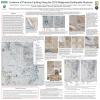Poster #011, Earthquake Geology
Geologic Effects of the March 2020 M 5.7 Magna, Utah, Earthquake
Poster Image:

Poster Presentation
2020 SCEC Annual Meeting, Poster #011, SCEC Contribution #10573 VIEW PDF
reat Salt Lake, and the foothills of the Wasatch Range and Oquirrh Mountains. The observed geologic effects from the Magna earthquake include liquefaction-induced sand boils and lateral spreading, tension cracks, localized subsidence, syneresis cracking, and some possible small rockfalls. The most intense liquefaction was close to the shore of Great Salt Lake and near the epicenter. The clearinghouse was established to collect, archive, preserve, and distribute valuable data on the earthquake. We present the results of this reconnaissance work and add to the observations accompanying seismological data for modern earthquakes in the western United States.
SHOW MORE
SHOW MORE






























